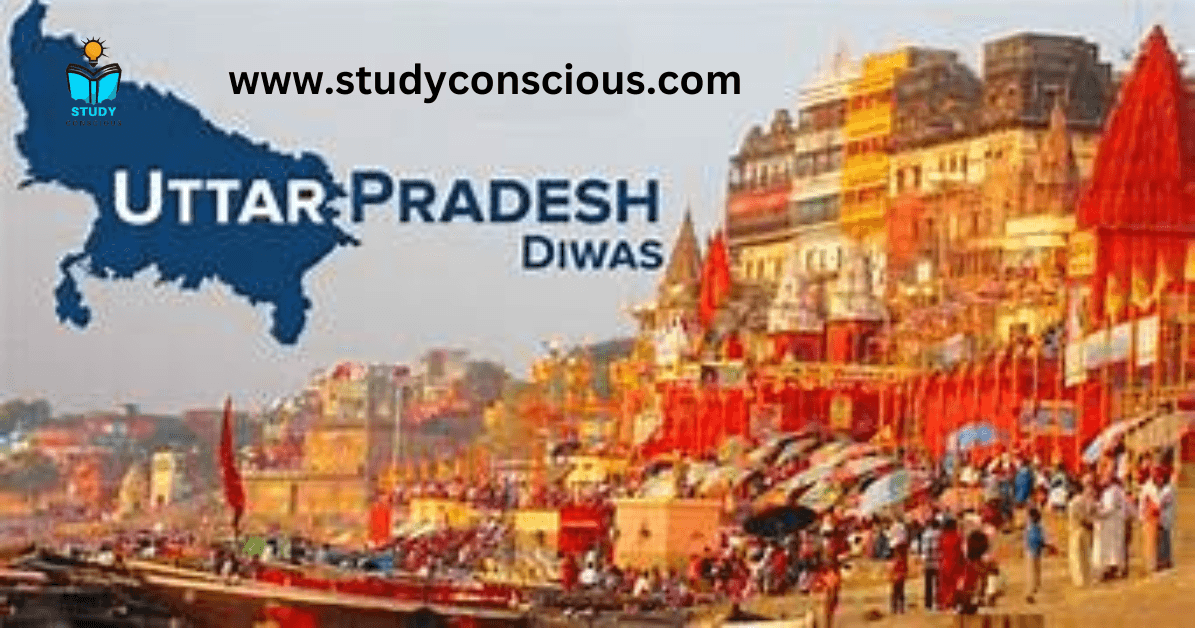Uttar Pradesh Foundation Day, also known as “UP Diwas,” is celebrated annually on January 24th. This day marks the formation of the state of Uttar Pradesh in 1950 when the United Provinces, under the British rule, were reorganized and renamed as Uttar Pradesh.
Key Highlights of UP Foundation Day:
- Cultural Programs: Events showcasing the diverse and rich cultural heritage of Uttar Pradesh, including traditional music, dance, and art exhibitions.
- Achievements Recognition: Awards and honors are often distributed to individuals and organizations for contributions to the state’s development.
- Development Announcements: The government highlights development initiatives and plans to promote economic growth and welfare in the state.
- Theme-based Celebrations: Each year, UP Diwas often revolves around a specific theme, emphasizing issues like innovation, tourism, or women’s empowerment.
- Historical Significance: The day reflects on the state’s journey and its contributions to India’s history, culture, and politics.
Uttar Pradesh (UP) is the most populous state in India and plays a pivotal role in the country’s history, culture, and politics. Here’s a detailed overview:
Geography and Demographics
- Location: Northern India; bordered by Uttarakhand, Himachal Pradesh, Haryana, Delhi, Rajasthan, Madhya Pradesh, Chhattisgarh, Jharkhand, Bihar, and Nepal.
- Area: 243,286 square kilometers (4th largest in India).
- Population: Over 240 million (2021 estimates), making it the most populous state in India.
- Major Cities: Lucknow (capital), Kanpur, Varanasi, Agra, Prayagraj, Meerut, Ghaziabad, Gorakhpur, and Noida.
- Languages: Hindi is the official language, with Urdu as a secondary official language.
History
- Ancient Era: Known as the birthplace of Hinduism, Buddhism, and Jainism. Cities like Varanasi and Ayodhya are among the oldest living cities in the world.
- Medieval Period: Ruled by various dynasties, including the Mughals, with Agra and Fatehpur Sikri as significant centers.
- Colonial Era: The region played a significant role in the First War of Independence (1857). Known as the United Provinces during British rule.
- Post-Independence: Renamed Uttar Pradesh in 1950; emerged as a politically influential state in India.
Economy
- Agriculture: A key agrarian state, producing wheat, sugarcane, rice, and mangoes. UP is India’s largest sugarcane producer.
- Industry: Strong in textiles, leather, and handicrafts. Major industrial hubs include Kanpur, Noida, and Ghaziabad.
- Tourism: Home to the Taj Mahal in Agra, Kashi Vishwanath Temple in Varanasi, and Sarnath, a major Buddhist site.
Culture

- Religion: UP is home to key religious sites for Hindus, Muslims, Buddhists, and Jains.
- Festivals:
- Holi, Diwali, Eid, and Christmas are widely celebrated.
- Unique festivals include Kumbh Mela (Prayagraj), Ram Navami (Ayodhya), and Ganga Mahotsav (Varanasi).
- Cuisine: Famous for dishes like kebabs, biryani, kachori, chaat, and sweets like pedas (Mathura) and petha (Agra).
- Art and Craft: Renowned for Chikankari embroidery (Lucknow), Banarasi sarees, and brassware (Moradabad).
Key Highlights
- Politics: Known for its political influence, UP sends the highest number of representatives (80) to the Lok Sabha.
- Education: Hosts prestigious institutions like Banaras Hindu University (BHU), Aligarh Muslim University (AMU), and Indian Institute of Technology (IIT) Kanpur.
- Infrastructure:
- Major airports: Chaudhary Charan Singh International Airport (Lucknow), Lal Bahadur Shastri International Airport (Varanasi).
- Expressways: Yamuna Expressway, Purvanchal Expressway, and Agra-Lucknow Expressway are key projects.
Notable People
- Historical Figures: Tulsidas, Kabir, Rani Lakshmi Bai, and Ram Manohar Lohia.
- Modern Personalities: Former Prime Ministers Jawaharlal Nehru, Atal Bihari Vajpayee, and Indira Gandhi hailed from UP.
Current Governance

- Chief Minister: Yogi Adityanath (as of 2025).
- Governor: Anandiben Patel (as of 2025).
- Focus Areas: Infrastructure development, law and order, and investment in healthcare and education
Ayodhya Ram Mandir
The Ayodhya Ram Mandir, also known as the Shri Ram Janmabhoomi Mandir, is a grand Hindu temple under construction in Ayodhya, Uttar Pradesh. It is dedicated to Lord Ram, believed to be born at this sacred site. The temple symbolizes cultural, spiritual, and historical significance for millions of Hindus worldwide.
Key Facts About the Ram Mandir
1. Historical Significance
- Ayodhya’s Heritage: Ayodhya is considered one of the seven sacred cities (Sapta Puri) in Hindu tradition. It is believed to be the birthplace of Lord Ram, as described in the epic Ramayana.
- Babri Masjid: A mosque was built at this site in 1528 during the Mughal period by Babur. Controversies over the site led to significant disputes.
- Ram Janmabhoomi Movement: Calls for reclaiming the site began in the late 19th century and intensified in the 20th century, leading to the demolition of the Babri Masjid on December 6, 1992.
2. Supreme Court Verdict (2019)
- After decades of legal battles, the Supreme Court of India delivered a landmark judgment on November 9, 2019:
- The disputed land was awarded to the Hindu side for temple construction.
- A separate 5-acre land was allocated to the Muslim community for a mosque in Ayodhya.
3. Temple Construction
- Foundation Laying Ceremony: The Bhoomi Pujan was conducted on August 5, 2020, by Prime Minister Narendra Modi.
- Design:
- Architect: Chandrakant Sompura, renowned for designing traditional Hindu temples.
- Style: Nagara-style architecture with intricate carvings on pink sandstone.
- Dimensions: The temple will be about 161 feet tall, featuring three stories and 366 intricately carved pillars.
- Materials: Sandstone from Rajasthan and other regions of India are being used.
- Estimated Completion: The temple is expected to open to devotees in January 2024, with full construction completed by 2025.
4. Temple Layout
- Main Shrine: Dedicated to Lord Ram, with a sanctum sanctorum housing the idol of Ram Lalla (infant form of Lord Ram).
- Other Features:
- A grand entrance, mandapas (pavilions), and a large courtyard.
- Adjacent facilities for visitors and pilgrims.
Significance of the Ram Mandir

- Spiritual Importance: Represents the return of Lord Ram to his rightful place, resonating with themes of dharma (righteousness) and faith.
- Cultural Heritage: A symbol of India’s ancient architecture and devotion.
- Tourism: Expected to attract millions of pilgrims and tourists, boosting Ayodhya’s economy.
- Unity and Identity: Seen as a resolution to a long-standing religious and cultural conflict in India.
Tourism and Development in Ayodhya
- Infrastructure Growth: Projects include airports, roads, hotels, and riverfront beautification.
- Deepotsav Festival: A grand celebration with millions of earthen lamps lit on the banks of the Saryu River during Diwali.











